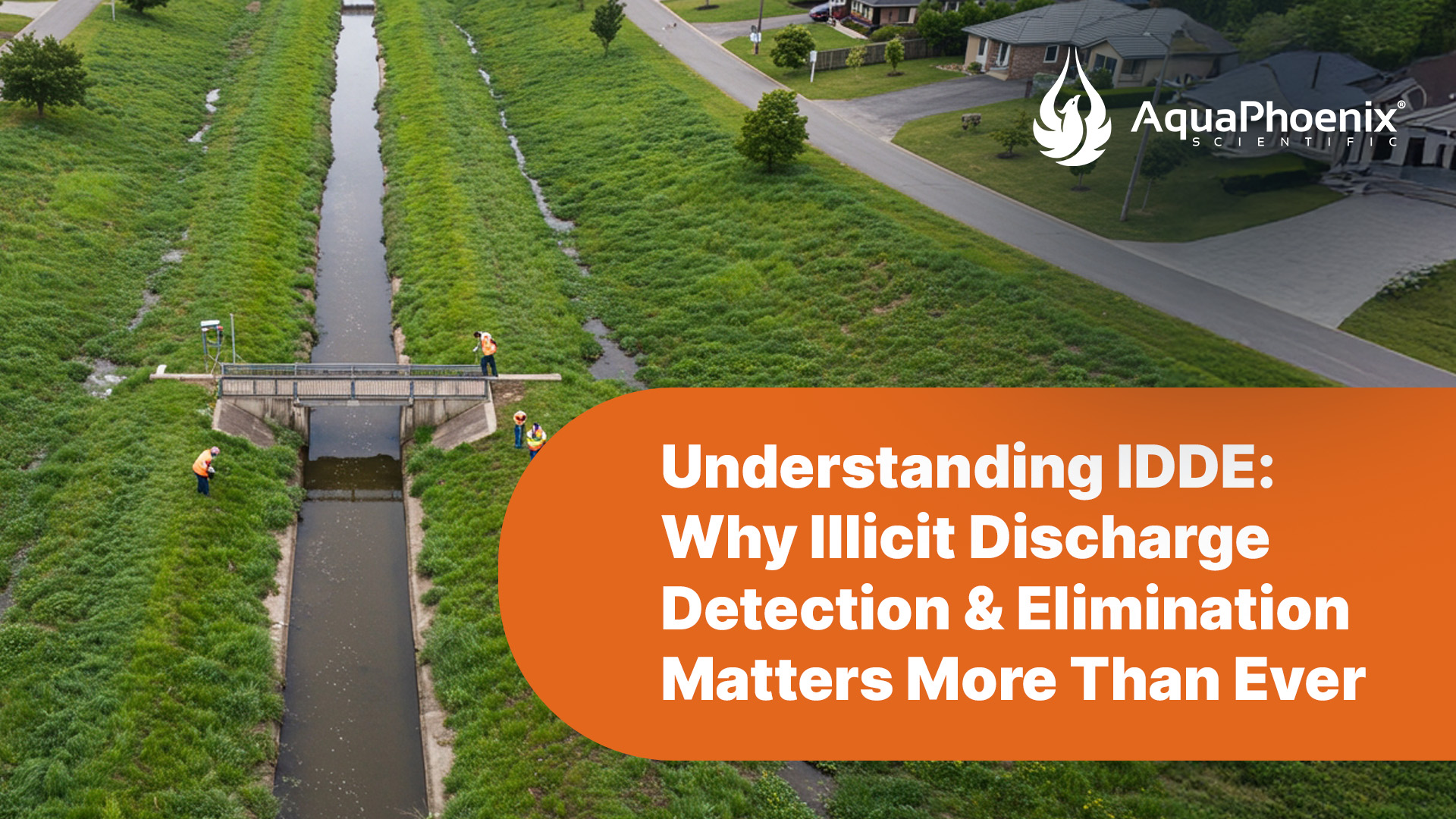In today’s world of heightened environmental awareness and regulatory oversight, water quality isn’t just a public health issue; it’s a legal and community imperative. That’s where Illicit Discharge Detection and Elimination (IDDE) comes in.
At AquaPhoenix, we understand the ins and outs of IDDE: how it works, why it’s crucial, and what municipalities and environmental professionals need to do to implement effective programs. Whether you’re new to IDDE or looking to strengthen an existing system, this guide will walk you through the essentials and demonstrate our deep commitment to protecting water resources through informed action.
What is IDDE?
IDDE stands for Illicit Discharge Detection and Elimination. It’s a required component of the EPA’s National Pollutant Discharge Elimination System (NPDES) permitting program for Municipal Separate Storm Sewer Systems (MS4s).
IDDE focuses on identifying and eliminating non-stormwater discharges – think sewage leaks, chemical runoff, industrial wash water, pet waste, or even spilled motor oil – that enter storm drains and flow directly into local water bodies without treatment.
Unlike sanitary sewers, which route waste to treatment plants, storm drains often discharge untreated runoff straight into rivers, lakes, and coastal waters. Even a minor illicit discharge can introduce bacteria, toxins, nutrients, or heavy metals that degrade water quality, harm aquatic life, and pose public health risks.
Why is IDDE Important?
- Protects Public Health: Helps prevent exposure to pathogens and chemicals that can make water unsafe for recreation, wildlife, or drinking water supply.
- Preserves Ecosystems: Minimizes stress on aquatic organisms by reducing harmful pollutants before they reach sensitive habitats.
- Supports Regulatory Compliance: Helps MS4 operators meet Clean Water Act obligations and avoid fines or enforcement actions.
- Builds Community Trust: Shows residents and stakeholders that you’re serious about protecting natural resources and operating responsibly.
Key Components of an Effective IDDE Program
A strong IDDE program isn’t just about reacting to problems, it’s about proactively preventing pollutants from unknowingly contaminating water sources. Here’s what a basic plan includes:
- Mapping and Inspection
Start by mapping all stormwater outfalls. These are the physical locations where storm sewers discharge to surface waters. A complete and up-to-date map forms the backbone of your IDDE program.
Next, conduct dry-weather inspections, at least 72 hours after rainfall, to detect flow when none should be present. If water is flowing during dry weather, something’s likely wrong.
2. Detection & Monitoring
Train your team to look for telltale signs:
- Visual: Staining, sediment, soap suds, or oil sheen
- Odors: Sewage, fuel, chemical smells
- Basic Field Testing: pH, temperature, conductivity, and ammonia levels can help identify pollutants
3. Tracing & Eliminating
Once an illicit discharge is detected:
- Use dye testing, smoke testing, or manhole inspections to trace it back to the source.
- Common causes include cross-connected pipes, leaking sanitary lines, or illegal dumping.
- Coordinate with public works or property owners to correct the issue, whether it’s repairing infrastructure or stopping improper practices.
4. Regulation & Enforcement
Many communities have IDDE ordinances that prohibit non-stormwater discharges and empower agencies to take enforcement actions. These range from written warnings and notices of violation to civil penalties and cost recovery for cleanup.
Enforcement ensures long-term compliance and sends a clear message that water protection is a community priority.
5. Record-Keeping & Reporting
Thorough documentation is essential:
- Keep field logs, inspection reports, sample results, and photos
- Track follow-up actions, resolutions, and compliance timelines
- Submit required reports annually to the relevant state or federal agencies under your MS4 permit.
Good data not only supports regulatory compliance, it provides evidence of progress and areas for improvement.
How to Become IDDE Compliant: Practical Tips for Municipalities
Getting started with IDDE, or enhancing your existing program, doesn’t have to be overwhelming. Here are proven, practical steps:
Prioritize Inspections
Some municipalities may inspect all outfalls annually. Larger municipalities may use risk-based prioritization, focusing on areas with older infrastructure, industrial activity, or past violations.
Use Efficient Field Forms
Whether it’s a simple yes and no checklist or a full GIS-integrated inspection app, choose a data collection method that works for your team and allows for consistent record-keeping.
Train Your Team
Staff must be trained to recognize pollution indicators, use testing equipment, and follow standard operating procedures. This ensures consistent, reliable fieldwork across your organization.
Engage The Public
Educate residents and businesses to recognize and report suspicious discharges. Community eyes and ears can dramatically increase your ability to detect and eliminate illicit flows.
Examples of citizen-reported issues include:
- Oily residue from a storm drain
- Foul odors in a local stream
- Car washing runoff entering the storm system
Be Proactive, Not Reactive
Prevention is the most cost-effective strategy. Implement public education campaigns, stormwater best practices, and cross-connection reviews before problems arise.
Why IDDE Works: The Results Speak for Themselves
An effective IDDE program delivers measurable benefits:
- Improves Water Quality: Reduces bacteria, nutrients, heavy metals, and hydrocarbons from entering waterways
- Supports Watershed Goals: Helps meet total maximum daily load targets and watershed restoration efforts
- Strengthens Community Ties: Demonstrates leadership in protecting local rivers, lakes, and coastal ecosystems
According to the EPA, municipalities that invest in IDDE programs often see immediate and long-term improvements in stormwater quality and community trust.
